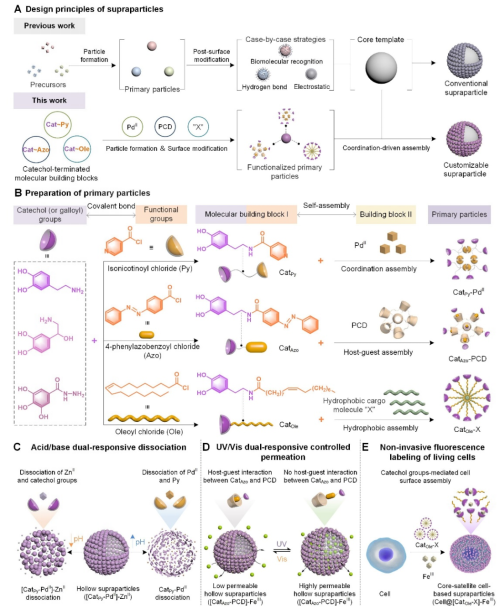Professor Junling Guo's team at the College of Biomass Science and Engineering has recently published a research achievement titled “Customizable Supraparticles Constructed from Catechol-Terminated Molecular Building Blocks with Controllable Intermolecular Interactions” inAngewandte Chemie- International Edition, a top international journal of chemistry. The corresponding authors of this paper are Junling Guo and Guidong Gong, an associate research fellow (full-time scientific research). The first authors are Yajing Zhang, a Class 2021 doctoral student of the CBSE; Jin Wang, a graduate of the College of Materials Science and Engineering of SCU (now a doctoral student of the Northwestern University, United States), and Yunxiang He, an associate research fellow of the CBSE (full-time scientific research).

The research team mainly focuses on the research of plant polyphenols in basic science and cutting-edge application fields. In early work, they explored the unique interface interactions of plant polyphenols and developed modular colloidal assembly methods. (Nat. Nanotech.2016, 11, 1105).Based on this study, the team constructed a yeast artificial photosynthetic system (Science,2018, 362, 813) and a cell therapy platform (Adv. Mater., 2020, 32, 2003492;Adv. Sci., 2023, 2207488). In addition, the team developed a protein like nucleic acid mesomorphic superstructure based on supramolecular assembly, with catechol basic structural unit as the core material (Sci. Adv. 2021, 7, eabh3482). Inspired by those achievements, the team came up with an integrated preparation strategy from parent molecules to superstructure particles by coupling pyrogallols in functional molecules.
“--- Herein, we developed a universal approach to construct customizable supraparticles with desired properties from molecular building blocks obtained by the covalent conjugation of catechol groups with a series of orthogonal functional groups. These catechol-terminated molecular building blocks can assemble into primary particles driven by various intermolecular interactions (i.e., metal-organic coordination, host-guest, and hydrophobic interaction), and then further assemble into supraparticles governed by catechol-mediated interfacial interactions. Our strategy enables supraparticles with diverse functionalities, such as dual-pH responsiveness, light-controllable permeability, and non-invasive fluorescence labeling of living cells. The ease with which these supraparticles can be fabricated, and the ability to tailor their chemical and physical properties through the choice of metals and orthogonal functional groups used, should enable a variety of applications.” (Abstract)

Figure 1. Customizable superparticles achieved through multi-level assembly of catechol capped functional molecular units
The research work was funded by the "National Natural Science Foundation of China (22178233, 22208228)", "National Key Research and Development Program (2022YFA0912800)", "Talent Fund of the National Engineering Research Center for Clean Tanning Technology", "Talent Fund of the State Key Laboratory of Polymer Materials Engineering (SKLPME 2020-3-01)", "Key Construction Fund of Double first-class Disciplines", etc.
https://onlinelibrary.wiley.com/doi/10.1002/anie.202303463
